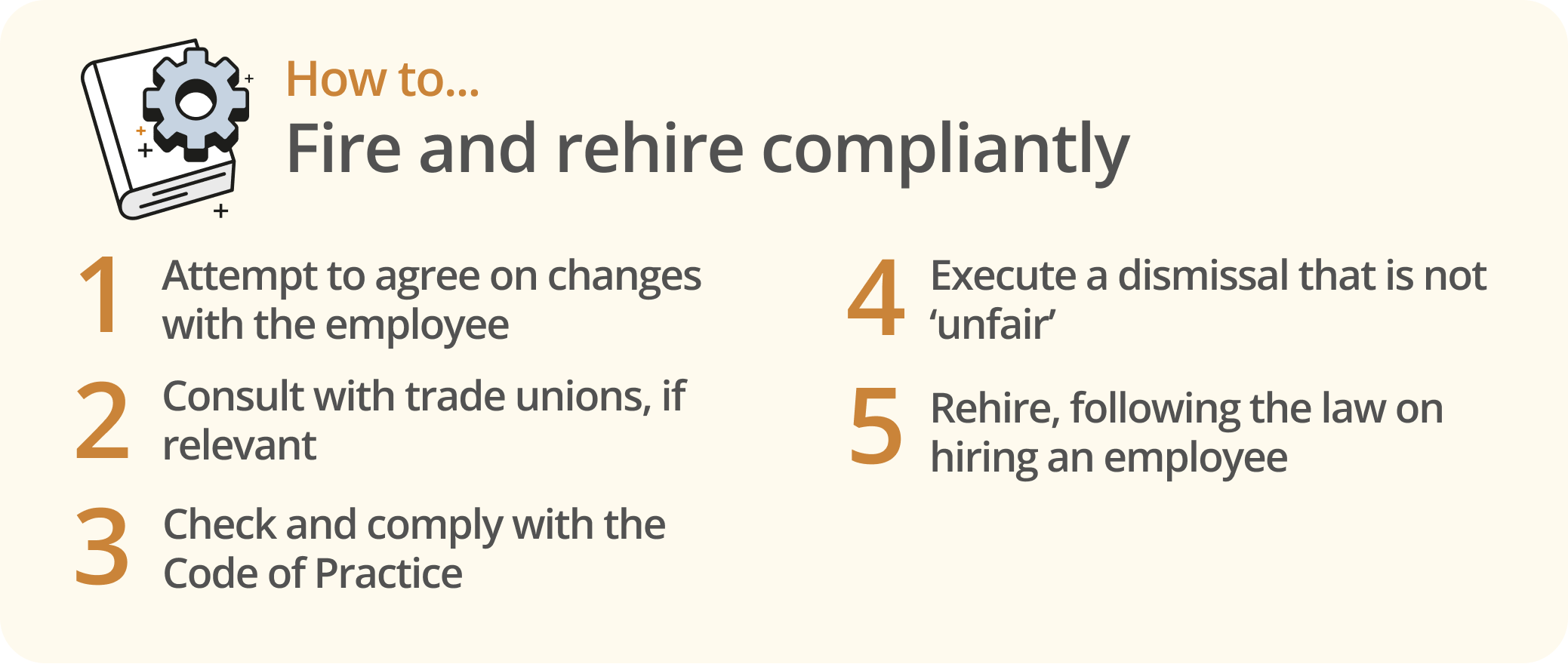What is fire and rehire?

‘Fire and rehire’ (also known as ‘dismissal and re-engagement’) is when an employer dismisses an employee and then offers them a new Employment contract, usually with different (often less favourable) terms. This could mean lower pay, reduced benefits, or changes to working hours.
While it might sound extreme, employers sometimes use this strategy when they need to make contractual changes that employees won’t agree to voluntarily. But just because it happens doesn’t mean it’s always fair—or lawful.
Is fire and rehire legal in the UK?
In short: yes, but within limits. There’s no specific law banning fire and rehire but, as with all dismissals, employers must follow fair procedures to avoid unfair dismissal claims.
A dismissal will be considered fair if the employer:
-
has a fair reason for the dismissal
-
follows a fair dismissal procedure
-
give the right amount of notice, and
-
offer employees the right to appeal against their dismissal
Generally speaking, fire and rehire should only be used as a measure of last resort, and any such dismissals will, in most cases, be considered unfair unless:
-
the employer’s business is experiencing serious financial difficulties
-
the changes are essential to keep the employer afloat, and
-
no other options are available to the employer
Alternatives to using fire and rehire
As fire and rehire should only be relied on when absolutely necessary, before using this tactic an employer should consider what alternatives are available to resolve challenges without resorting to fire and rehire. These include, but are not limited to:
-
consulting with employees – having open, meaningful discussions with employees, trade unions, or employee representatives can lead to compromises, such as flexible working arrangements instead of reduced benefits
-
reviewing existing contracts for flexibility clauses – some contracts may include clauses allowing the employer to make minor changes without needing employee consent. However, major changes (such as pay reductions) require agreement (eg via a Change to employment terms letter). For more information, read Changing employment terms
-
considering redundancies – in some cases, making a few roles redundant or offering voluntary redundancies may be a better option than changing terms for the entire workforce
-
voluntary adjustments – employers should explore voluntary agreements, redeployment, or other cost-saving measures. Some employees may agree to reduced pay or benefits if given clear options and transparency
-
new terms for new employees – gradually introducing changes through new contracts for incoming staff avoids sudden disruption. However, be careful when creating disparities between employees’ terms of employment
-
promotions – implementing new terms as part of negotiations when promoting employees ensures contract changes are agreed upon willingly
Considerations before using fire and rehire
When considering firing and rehiring an employee, employers should bear the following legal considerations in mind to help them comply with the law:
-
consultations – employers should engage with employees and their representatives before making changes
-
fair dismissal rules – if an employee is dismissed, the employer must show a legitimate business reason and follow a fair dismissal process
-
notice periods – when dismissing someone, proper notice must be given in line with their employment contract and the statutory requirements
-
discrimination laws – if the fire and rehire process disproportionately affects certain groups, it could lead to discrimination claims
-
the Statutory Code of Practice – employers should follow the government’s Code of Practice on Dismissal and Re-Engagement, and failure to comply with this code can result in increased compensation awards by Employment Tribunals if a dismissed employee opens an employment dispute
How should employers approach fire rehire if there is no alternative?

If fire and rehire is unavoidable, employers must take a fair and structured approach when implementing this strategy:
Secure employee agreement
Before resorting to fire and rehire, employers should aim to secure agreement on contractual changes through meaningful consultation. This means:
-
providing clear business reasons for the changes
-
outlining who will be affected and the expected timeline
-
exploring alternative solutions and allowing employees to propose counteroffers
If changes to employment terms are agreed to, the employer must still issue written notice of the agreed-upon contractual changes at least one month before they take effect.
If employees do not consent to changes, employers should not unilaterally impose such changes, as this can lead to legal disputes.
Employers should not bypass trade unions where collective bargaining applies. Formal agreements can be documented via:
-
a new Employment contract
-
a side letter amending an existing contract (eg a Change to employment terms letter)
-
collective agreements (where applicable)
Note that special rules apply to employers proposing to fire and rehire 20 or more employees. For more information, see Acas’ guidance on dismissal and rehire.
Follow correct dismissal procedures
As a fire and rehire involves a dismissal, employers must follow fair dismissal protocols. This includes:
-
ensuring there is a legitimate business reason for dismissal
-
providing the appropriate notice period in line with the employee’s employment contract and legal requirements
-
complying with a clear and fair dismissal procedure, including consultation with affected employees
-
complying with equal opportunities and discrimination laws (eg if fire and rehire disproportionately affects certain groups, this could lead to discrimination claims)
For more information, read Dismissal and follow our Dismissal checklist.
Comply with the Statutory Code of Practice
When considering and using fire and rehire practices, employers should follow the government’s Code of Practice on Dismissal and Re-Engagement. This Code of Practice sets out employers’ responsibilities in relation to fire and rehire practices.
While the Code isn’t legally binding, it is admissible in evidence in legal proceedings. This means that, if a case is brought against an employer, the Code must be considered by the courts and Employment Tribunals. From January 2025, if it is found that an employer did not comply with the Code, this can result in up to a 25% increase in the amount of compensation awarded to affected employees.
What do employees need to know about fire and rehire practices?
If your employer is proposing fire and rehire, you have rights. You can:
-
negotiate – you don’t have to accept changes immediately. Seek legal advice if needed
-
join a trade union – many unions challenge fire and rehire practices on behalf of workers
-
claim unfair dismissal – if you have at least two years of service and the dismissal is unfair, you could take legal action against your employer
-
report bad practices – the government and regulators are increasingly scrutinising employers who misuse fire and rehire
Bear in mind that you do not have to accept a fire and rehire proposal.
Accepting a fire and rehire proposal
If you agree to the proposed fire and rehire, you should let your employer know. They will likely ask you to sign a new contract, which you should read carefully. Raise any concerns that you have about the new contract and its terms. Your new contractual terms should not take effect until after your old contract has come to an end.
Bear in mind that, when you are being dismissed, your employer must give you the correct amount of notice. This applies even if you are being re-engaged by the same employer.
When being fired and rehired, you will usually keep your 'period of continuous employment' (ie the calculated length of service with your employer, which is used to determine your eligibility for certain employment rights).
Rejecting a fire and rehire proposal
If you do not agree to a proposed fire and rehire, you should let your employer know.
If you do not accept because you believe your dismissal to be unfair, you should appeal against your employer's decision. You can do this using an Appeal letter. For more information, read Appealing decisions made by employers.
If such an appeal is unsuccessful, your employment will come to an end when your notice period ends. If you believe your dismissal to be unfair despite a failed appeal, you can bring a claim against your employer at an Employment Tribunal.
If you’re considering taking legal action against your employer, you should seek advice on your situation. Speak to your trade union representative, Ask a lawyer, or contact the Acas helpline.
Whether you’re an employer or an employee, fire and rehire is a complex area of employment law that requires careful consideration. Understanding the legal framework, employee rights, and best practices can help both sides navigate this challenging issue effectively. If you have any questions or concerns about fire and rehire or employment law in general, Ask a lawyer.





